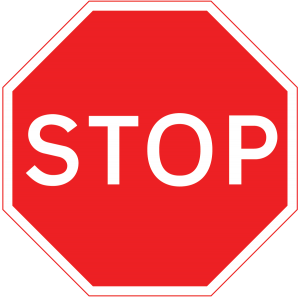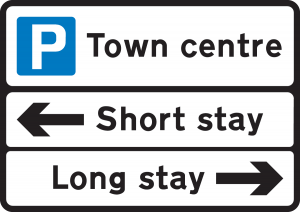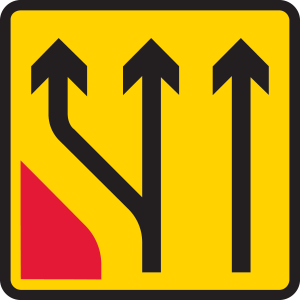Road signs and traffic signs provide road users with important information to keep them safe on the road. It is vital that you make an effort to learn their meanings and what actions to follow when you see them. Take this short road signs test to see how well you know your signs:

Road Signs Test
Assess your road signs knowledge with this test.There are 30 questions in total. You need to score 25 to pass. You can check your answers after each question or you can review all of your answers at the end of the test. Good luck!
There are hundreds of road signs which come in different sizes, shapes and colours. The shape and colour of a sign will tell you its meaning and give different information. Many of these traffic signs are quite intuitive and easy to follow. For example, a rectangular blue sign reading ‘end of bus lane’ simply marks the end of a bus lane. Other road signs however aren’t as easy to figure out so it’s imperative that you spend time learning what these signs are.

Contents
Road Sign Shapes
There are three types of road sign shapes: circular, triangular and rectangular:
You can learn the shapes of road signs and their meanings by remembering the following:
Road Sign Colours
The first thing that you will probably notice when looking at a road sign is its colour. The colour of a road sign will determine what kind of message it’s trying to convey. There are five colours that you will often see, each with its own distinctive message as outlined below:
| Colour | Meaning |
|---|---|
| Red | This tells you NOT to do something OR to take notice |
| Blue |
|
| Green | This tells you the direction of primary routes |
| White | This tells you the direction of NON-primary routes |
| Yellow | This tells you about roadworks OR information relating to events and parking |
Blue
Blue road signs have two primary uses for roads in the UK. These depend on the shape of the traffic sign.
Blue circular signs
Most commonly, blue signs give mandatory instruction i.e. they tell you something that you MUST do. For example, the sign below tells you that you must proceed in the direction indicated.
Blue circular road signs may also indicate which sort of road user can use a particular route, eg cyclists, pedestrians, buses, trams, taxis etc. The sign below indicates that the route is designated for cyclists and pedestrians.
 Blue rectangular signs
Blue rectangular signs
Blue rectangular signs are primarily used to show information about the road you’re on. For example, the sign below indicates the distance to a car park ahead.
You will also see blue road signs on motorways. Here, blue rectangular road signs provide directions.
Red
In most cases, a red sign orders you NOT do something.
Red circular signs
If a circular sign has a red ring around its perimeter, it means you must not do whatever is displayed on the sign. For example, if ’40’ is displayed on this type of sign, it means you must not exceed 40 miles per hour.
Red triangular signs
Red triangular signs usually contain warnings. For example, the sign below warns you of traffic lights ahead.
Red triangular signs may also be inverted as in the case of the sign below which warns of you of a give way.
Red rectangular signs
Rectangular signs with a red background usually contain warning messages. The sign below warns road users to reduce their speed:
Stop sign
The red stop sign doesn’t fall into any of the three categories of shape (circular, triangular or rectangular). The shape of a stop sign, an octagon, is exclusively reserved for this particular sign owing to the great importance of its message and also so that it can be seen even if it is partly covered, for example, by snow.
Green
In almost all cases, green road signs are rectangular, although there is an exception to the rule.
Green rectangular signs
In the vast majority of cases, green traffic signs provide direction information on primary routes that aren’t motorways. The sign below indicates that a non-primary route passes through a bypassed town or village:
Green circular signs
Green circular signs are reserved for manually operated signs used at roadworks or blockages to indicate you must ‘GO’.
White
In most cases, white road signs are rectangular in shape.
White rectangular signs
White rectangular signs give directions on non-primary routes. The sign below gives directions to different types of parking places:
They can also be used in conjunction with warning and regulatory signs. The sign below is one such example:
National speed limit sign
The national speed limit sign is the only white road sign that is circular in shape.
Yellow
Yellow rectangular signs
In the majority of cases, you will find yellow road signs where roadworks are being undertaken. These signs will almost always be rectangular. The sign below indicates a motorway contraflow system.
Yellow is also sometimes used to provide information, such as those signs displaying parking information.
Learning UK Road Signs
Although you don’t need to strictly know the meaning of every single road sign in order to pass your theory and driving tests, knowing and understanding as many as possible will certainly make you a better driver. By knowing what the road signs mean and being able to act upon them, you’ll be at a lower risk of being involved in an incident or falling foul of the law.
Below are several other reasons why it is imperative to learn and understand road signs:
- Reducing risk from hazardous conditions. Road signs help you to understand if roads are more likely to be hazardous during certain seasons.
- Understanding and planning your route. Road signs make it easier to drive in unfamiliar areas as they provide information about the roads you are driving on.
- Avoiding getting lost. Road signs should prevent you from losing your way during a journey and can be used to facilitate a smooth journey to your destination.
How to Revise UK Road Signs
Learning traffic signs can be quite difficult. Fortunately, by learning the general principles associated with the shapes and colours of road signs, it will make it easier to interpret the meanings of various symbols and nuances associated with the combination of colours and shapes. Below are some additional useful tips to aid in your learning and revision of UK road signs.
Learn the Fundamentals
Before diving head first into learning the specifics of each road sign, take some time to learn and understand the meanings behind the colours and shapes associated with them. By putting these fundamentals to memory, you’ll be half way there.
Use a Step by Step Approach
Don’t take on too much too quickly. Attempting to learn every single road sign in one sitting will be counterproductive. Learning the meanings and gaining an understanding of road signs is a process that takes time, so you should learn small amounts consistently.
For example, you could create a schedule whereby you learn ten new signs a day and revise the signs that you’ve learnt in previous sessions. The more familiar you become with road signs, the faster you’ll learn them as you’ll be able to apply your existing knowledge of road signs to new ones you come across.
Don’t leave everything to the last minute, especially if you’re revising for your theory test. Remember, you will be faced with a number of questions about road signs on your theory test, which could be the difference between a pass and a fail.
Draw the Signs
A great way to learn road signs is by drawing them out. As you put pen to paper, you’re forced to pay attention to the detail of each sign enabling you to embed it in your mind. Whilst you won’t want to or need to do this for every single road sign, it’s a good idea for ones you’re struggling to remember.
Go Outside
Looking at and trying to learn a list of signs from a website or a book can be somewhat daunting, so it’s a good idea to go out and look at signs in your local area. If you’re unfamiliar with a sign, try to work out what it means by observing how traffic responds to it. You can also keep a lookout for traffic signs whilst you’re a passenger in a vehicle.
Use this Website
We have several features on this website to help you with your learning and revision:
- Road signs test – we provide a free online test you can use to assess your knowledge and understanding of road signs. You should take this test periodically to see how well you’re doing. By signing up for an account you’ll be able to track your progress.
- Database – we have a database of all the road signs you might come across on the road. You can use this database to find specific signs by name, colour or shape. There are more than 600 signs in this database. Keep in mind that you don’t have to memorise every single road sign that appears here. By signing up for an account, you’ll also have the added benefit of being able to save specific road signs to your user dashboard that you can later revisit.
- Highway Code – the Highway Code has a section dedicated to road signs. You can access this for free here.





















